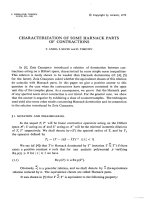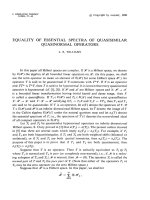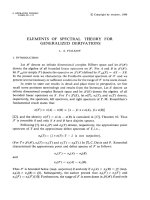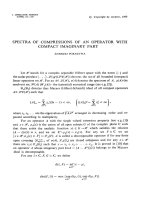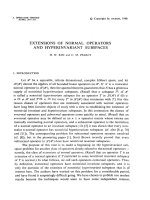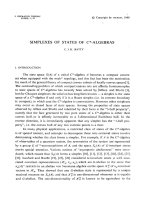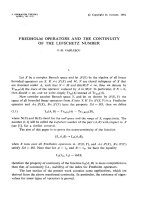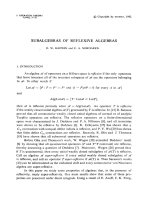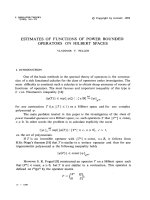Báo cáo toán học: "Traces of uniform families of sets" docx
Bạn đang xem bản rút gọn của tài liệu. Xem và tải ngay bản đầy đủ của tài liệu tại đây (97.52 KB, 5 trang )
Traces of uniform families of sets
Bal´azs Patk´os
∗
Submitted: Aug 24, 2008; Accepted: Feb 23, 2009; Published: Mar 4, 2009
AMS Mathematics Subject Classification: 05D05
Abstract
The trace of a set F on a another set X is F |
X
= F ∩ X and the trace of a
family F of sets on X is F
X
= {F |
X
: F ∈ F}. In this note we prove that if a
k-uniform family F ⊂
[n]
k
has the p roperty that for any k-subset X the trace F|
X
does not contain a maximal chain (a family C
0
⊂ C
1
⊂ ⊂ C
k
with |C
i
| = i), then
|F| ≤
n−1
k−1
. This bound is sharp as shown by {F ∈
[n]
k
, 1 ∈ F }. Our proof gives
also the stability of the extremal family.
1 Introduction
Let [n] denote the set of the first n positive integers {1, 2, , n}. Given a set X we
write 2
X
for its power set and
X
l
for the set of all of its l-element subsets (l-subsets
for short). Given a family F ⊆ 2
X
of sets and an element x ∈ X we write F
x
for the
subfamily of all the sets in F that contain x and F
x
for the family {F \ {x} : F ∈ F
x
}.
The degree of x is the size of F
x
.
The tra ce of a set F on another set X is F ∩ X and is denoted by F |
X
. The trace
of a family F of sets is just the family of traces, i.e. F|
X
= {F |
X
: F ∈ F}. The
following fundamental result concerning traces of families was proved in the early 1970s
independently by Sauer [11], Shelah [12] and Vapnik and Chervonenkis [13].
Theorem 1.1. If F ⊆ 2
[n]
is a f amily with more than
k−1
i=0
sets, then there exists a
k-subset X of [n] such that F|
X
= 2
X
.
The above theorem is sharp as shown by the families {F ⊆ [n] : |F | < k} and
{F ⊆ [n] : |F | > n−k}, but no characterization is known for the extremal families. F¨uredi
and Quinn [7] constructed extremal families F
l
of size
k−1
i=0
for all l with 0 < l < k such
that for any k-subset X o f [n] we have
X
l
⊆ F|
X
.
Frankl and Pach [5] considered the k-uniform case of the problem. They proved the
following upper bound.
∗
Department of Computer Science, E¨otv¨os Lor´and University, Budapest, 1117 P´azm´any P´eter s´et´any
1/C, Hungary. Ema il: Supported by OTKA NK 67867.
the electronic journal of combinatorics 16 (2009), #N8 1
Theorem 1.2. If F ⊆
[n]
k
and |F| >
n
k−1
, then there is a k-subset X of [n] such that
F|
X
= 2
X
.
Frankl and Pach conjectured {F ∈
[n]
k
: 1 ∈ F } to be an extremal family of size
n−1
k−1
,
but Ahlswede and Khachatrian [1] disproved their conjecture by giving a counterexample
of size
n−1
k−1
+
n−4
k−3
. Later Mubayi and Zhao [9] gave exponentially many pairwise non-
isomorphic families of that size and improved the upper b ound of Frankl and Pach, but
the problem is still open.
Several papers [2], [3], [10] dealt with “Tur´an-type” problems of tr aces, i.e. given one
or more families H
1
, H
2
, , H
s
⊆ 2
[h]
what is the maximum size of a family F ⊆ 2
[n]
such
that for any h-subset X of [n] and 1 ≤ i ≤ s the trace F|
X
does not contain H
i
. With
this fo rmulation in Theorems 1.1 and 1.2 the excluded fa mily is 2
[k]
.
In [10] it is proved (among others) t hat if we change 2
[k]
to the maximal chain C
k
=
{∅, [1], [2], , [k]} in Theorem 1.1, then the only extremal families are {F ⊆ [n] : |F| < k}
and {F ⊆ [n] : |F | > n − k}. In this note we consider the corresponding k-uniform
problem and prove that the conjecture of Frankl and Pach becomes true in this scenario
if again we change 2
[k]
to C
k
. Furthermore we prove the stability of the extremal family
{F ∈
[n]
k
: 1 ∈ F }.
Theorem 1.3. For every in teger 2 ≤ k and real 1/2 < c < 1 there exists an N
0
(k, c) such
that for any n ≥ N
0
(k, c) if F ⊆
[n]
k
has size larger than c
n−1
k−1
and there is no subset
X of [n] with |X| = k such that C
k
⊆ F|
X
, then there exists an x ∈ [n] such that x ∈ F
for all F ∈ F.
Clearly Theorem 1.3 is a generalization of the well-known Erd˝os-Ko-Rado theorem
[4], therefore it is not surprising that our proof will use t he following stability theorem of
Hilton and Milner [8].
Theorem 1.4. If 2k+1 ≤ n and F ⊆
[n]
k
is an intersecting family such that
F ∈F
F = ∅,
then |F| ≤
n−1
k−1
−
n−k−1
k−1
+ 1.
2 Proof of Theorem 1.3
First we prove a lemma stating that if we want to have an “almost” maximal chain
C
−
k
= {[1], [2], , [k]} as trace, then much smaller families suffice.
Lemma 2.1. For eve ry integer 2 ≤ k and real 1/2 < c
′
< 1 there exists an N
′
0
(k, c
′
) such
that for any n ≥ N
′
0
(k, c
′
) if F ⊆
[n]
k
has size larger than c
′
n−1
k−1
then there exists a set
X ⊂ [n] with |X| = k such that C
−
k
⊆ F|
X
.
Proof of Lemma: We proceed by induction on k. For k = 2, if there exists an inter-
secting pair of 2-sets F
1
, F
2
∈ F, then ∅ = F
1
|
F
2
⊂ F
2
is a C
−
2
. Therefore F is a pairwise
disjoint family and thus |F| ≤ n/2 < c
′
(n − 1) f or any 1/2 < c
′
if n is large enough.
Now suppose the lemma is proved for k −1 and any real between 1/2 and 1. For a real
c
′
fix an M > N
′
(k − 1,
c
′
+1/2
2
) such that the following inequalities hold for all n ≥ M
the electronic journal of combinatorics 16 (2009), #N8 2
c
′
− 1/2
2
n − 2
k − 2
>
n − 2
k − 2
−
n − k − 2
k − 2
, (1)
c
′
n − 2
k − 2
+
n − 3
k − 2
>
n − 2
k − 2
. (2)
The existence of such M for (1) follows fro m the f act that if we consider the two sides of
(1) as po lynomials of n, then the degree of the LHS is one larger than the degree of the
RHS and for (2) from c
′
> 1/2 and from lim
n→∞
n−2
k−2
/
n−3
k−2
= 1 .
Let N
′
(k, c
′
) = M +1+2
M+1
k−1
, n ≥ N
′
(k, c
′
) a nd F ⊆
[n]
k
a family with |F| ≥ c
′
n−1
k−1
.
Let x
1
∈ [n] be an element with maximum degree which is at least the average degree
c
′
n−1
k−1
k
n
≥ c
′
n−2
k−2
and consider F
x
1
. By the inductive hypothesis there exists a (k − 1)-
subset X ⊂ [n] \ {x
1
} such that F
x
1
|
X
contains C
−
k−1
. Just by removing these sets one
after the other and repeatedly using the inductive hypothesis we get that G = {X ∈ F
x
1
:
C
−
k−1
⊆ F
x
1
|
X
} has size at least (c
′
−
c
′
+1/2
2
)
n−2
k−2
=
c
′
−1/2
2
n−2
k−2
. If two sets X
1
, X
2
∈ G are
disjoint, then writing F
1
= X
1
∪ {x
1
}, F
2
= X
2
∪ {x
1
} both F|
F
1
and F|
F
2
contain C
−
k
as
F
1
|
F
2
= F
1
∩ F
2
= F
2
|
F
1
= {x}. Thus we may assume that G is intersecting and thus by
Theorem 1.4 and (1) there exists an x
2
∈ [n] \ {x
1
} such that x
2
∈ X for all X ∈ G.
Let us assume t hat t here is a set F
′
∈ F
x
1
with x
2
/∈ F
′
. We claim that there is a
set X ∈ G such that F
′
∩ X = ∅. Indeed, the number of (k − 1)-sets containing x
2
and
meeting F is
n−2
k−2
−
n−k−2
k−2
, thus again by (1) there is a set X ∈ G as claimed. By the
definition of G there are sets F
2
, F
3
, , F
k
∈ F
x
1
such that their traces on X form a C
−
k−1
.
Writing F = X ∪ {x} we have F
′
|
F
= {x
1
} and thus the traces of F
′
, F
2
, F
3
, , F
k
on F
form a C
−
k
proving the lemma in this case.
Otherwise all sets in F
x
1
contain x
2
and thus as x
1
is of maximum degree x
1
and x
2
are contained in the same sets of F. The number of sets in F containing both x
1
and x
2
is at most
n−2
k−2
, thus removing these sets from F there remains a family F
1
of subsets
of [n] \ {x
1
, x
2
} of size at least
c
′
n − 1
k − 1
−
n − 2
k − 2
= c
′
n − 1
k − 1
−
n − 2
k − 1
+
n − 2
k − 1
−
n − 3
k − 1
−
n − 2
k − 2
+ c
′
n − 3
k − 1
= c
′
n − 2
k − 2
+
n − 3
k − 2
−
n − 2
k − 2
+ c
′
n − 3
k − 1
≥ c
′
n − 3
k − 1
+ 1,
where the last inequality follows by (2).
Let us consider an element x
3
∈ [n] \ {x
1
, x
2
} with maximum degree in F
1
. Repeating
the above argument we either find a set X ⊂ [n]\{x
1
, x
2
} such that C
−
k
⊂ F
1
x
3
|
X
⊂ F|
X
or
we have an element x
4
∈ [n] \ {x
1
, x
2
, x
3
} such that x
3
and x
4
are contained in exactly the
same sets of F
1
. Removing these sets from F
1
we obtain a family F
2
⊂
[n]\{x
1
,x
2
,x
3
,x
4
}
k
with size at least |F
1
| −
n−4
k−2
≥ c
′
n−3
k−1
−
n−4
k−2
+ 1 which is by (2) greater or equal to
c
′
n−5
k−1
+ 1 + 1 = c
′
n−5
k−1
+ 2.
the electronic journal of combinatorics 16 (2009), #N8 3
Repeating the above argument l times, we either find a set X such that C
−
k
⊆ F
l−1
|
X
⊆
F|
X
or subfamily F
l
⊆
[n]\{x
1
,x
2
,z
3
,x
4
, ,x
2l−1
,x
2l
}
k
∩ F
l−1
with size at least c
′
n−2l−1
k−1
+ l.
Thus we either find a set X such that C
−
k
⊆ F
l
|
X
⊆ F|
X
for some l ≤
n−M
2
or as
n ≥ M + 1 + 2
M+1
k−1
we obtain a subfamily of F on M or M + 1 elements (depending on
the parity of n) with size larger than
M+1
k−1
, and thus by Theorem 1.2 we even find a 2
[k]
as trace which proves t he lemma.
To prove the theorem for some k and c, let us fix an integer N(k, c) larger than
N
′
(k,
c+1/2
2
) of the Lemma such that for any n ≥ N(k, c) the following inequality holds
c − 1/2
2
n − 1
k − 1
>
n − 1
k − 1
−
n − k − 1
k − 1
+ 1. (3)
Let F ⊂
[n]
k
be a family with size at least c
n−1
k−1
. We claim that the size of the set
H = {X ⊂ [n] : |X| = k, C
−
k
⊆ F
X
} is at least
c−1/2
2
n−1
k−1
. Indeed, using Lemma 2.1 to
F we obtain 1 set in H, then removing this set from F and applying the Lemma again
we get another set and so on until the remaining family contains less set than
c+1/2
2
n−1
k−1
sets. If there is a pair of disjoint sets X
1
, X
2
∈ H, then X
1
∩ X
2
= ∅ extends this to a C
k
,
thus we may assume that those sets form an intersecting family, therefore by Theorem
1.4 and (3) there must exist an element x ∈ [n] such that x ∈ X for all X ∈ H. Any
set F ∈ F \ H must meet all sets in H as otherwise F |
X
= F ∩ X = ∅ would complete
C
−
k
⊆ F|
X
to C
k
. But this can happen only if F contains x as otherwise the number of
k-sets containing x and meeting F would be
n−1
k−1
−
n−k−1
k−1
which is by (3) smaller than
c−1/2
2
n−1
k−1
≤ |H|. Thus all sets in F contain x which proves the theorem.
Remark
Frankl and Watanabe [6] strengthened the conjecture of Frankl and Pach to the fol-
lowing: for every k ≤ m there exists an N = N(k, m) such that for any n ≥ N and
family F ⊆
[n]
m
with size larger than
n−m+k−1
k−1
there is a k-subset X of [n] such that
2
[k]
= F|
X
. The counterexample of Ahlswede and Khachatrian can be extended to the
k < m case. It is natural to ask what happens if we change again 2
[k]
to C
k
. Our proof
does not carry through mainly because of two reasons: X
1
∩ X
2
= ∅, |X
1
| = |X
2
| = k,
F ⊆
[n]
m
, C
−
k
⊆ F|
X
1
, F|
X
2
does not imply C
k
⊆ F|
X
1
if k < m and two different m-sets
F
1
, F
2
may have F
1
|
X
= F
2
|
X
= X for some k-set X. However, we conjecture that an
analogous statement for the k < m case is true.
Conjecture 2.2. For any pair of integers 2 ≤ k ≤ m and F ⊆
[n]
m
with |F| >
n−m+k−1
k−1
there exists a k-subset X of [n] such that C
k
⊆ F|
X
.
The bound (if true) would be sharp as shown by the family {F ∈
[n]
m
: [m−k+1] ⊂ F }.
Acknowledgement. The author would like to thank the anonymous referee for
his/her careful reading and valuable comments.
the electronic journal of combinatorics 16 (2009), #N8 4
References
[1] R. Ahlswede, L. Khatchatrian, Counterexample to the Frankl-Pach conjecture
for uniform, dense families, Combinatorica 17 (1997), 299-3 01.
[2] J. Balogh, B. Bollob
´
as, Unavoidable traces of set systems, Combinatorica, 25
(2005), 633-643.
[3] J. Balogh, P. Keevash, B. Sudakov, Disjoint representability of sets and their
complements, Journal of Combinatorial Theory B, 95 (2005), 12-28.
[4] P. Erd
˝
os, C. Ko, R. Rado, Intersection theorems for systems of finite sets, Quart.
J. Math. Oxford, 12 (1961), 313-318.
[5] P. Frankl, J. Pach, On disjointly representable sets. Combinatorica 4 (198 4),
39-45.
[6] P. Frankl, M. Watanabe, Density results for uniform families, Combinatorica
14 (1994 ) , 115-119.
[7] Z. F
¨
uredi, F. Quinn, Traces of finite sets, Ars C ombin., 18 (1984 ) 195-200.
[8] A.J.W. Hilton, E.C. Milner, Some intersection theorems for systems of finite
sets, Quart. J. Math. Oxford, 18 (1967), 369-384.
[9] D. Mubayi, J. Zhao, On the VC-dimension of uniform hypergraphs, Journal of
Algebraic Comb i natorics 25 (2007) 101-110.
[10] B. Patk
´
os, l-trace k-Sperner families, submitted.
[11] N. Sauer, On the density of families of sets, Journal of Combinatorial Theory A 13
(1972), 145-147.
[12] S. Shelah, A combinatorial problem; stability and order for models and theories in
infinitary languages, Pacific J. Math 41 (1972), 271-27 6.
[13] V.N. Vapnik, A. Ya. Chervonenkis, The uniform convergence of relative fre-
quencies o f events to their probabilities, Theory Probab Appl. 16 (1971), 264-279.
the electronic journal of combinatorics 16 (2009), #N8 5

